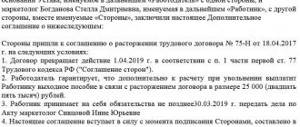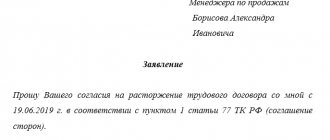Before signing an agreement with the owner when terminating an employment contract, you need to know what such a procedure means and what consequences it may entail. Dismissal by agreement of the parties is a fairly peaceful basis for terminating an employment contract, which allows you to settle the end of mutual obligations between the employee and the employer.
This procedure is used in various situations and does not have a negative impact on the reputation of the employee and the enterprise. Dismissal on this basis allows you to terminate the relationship of the parties as soon as possible and agree on conditions that will suit both the employer and the employee. This procedure is practiced when terminating an employment contract with employees who cannot be dismissed for other reasons without violating labor laws. The correct sequence of actions in this process will minimize the risk of mutual claims, litigation and other unpleasant consequences.
Dear readers! The articles contain solutions to common problems. Our lawyers will help you find the answer to your personal question
free of charge To solve your problem, call: You can also get a free consultation online.
What does dismissal by agreement of the parties mean?
An agreement between the parties (employee and employer) is a separate basis for the dismissal of an employee, established by an article of the Labor Code of the Russian Federation.
As the name suggests, this is possible if the parties have agreed on all the essential points of termination of the employment relationship - the date of dismissal, additional compensation payments, etc. If such agreement is not reached, then the employee has the right to resign of his own free will, having notified the employer at least two weeks in advance (Article of the Labor Code of the Russian Federation). The employer may also be the initiator of the separation. To do this, it is necessary to have the conditions defined in the Article of the Russian Federation (for example, reduction in number or staff, etc.).
Compose HR documents using ready-made templates for free
What to pay attention to when making an application
The law does not provide for any unified forms or restrictions for drawing up an application, so you can write it in any form or according to a template valid within the company. It is only important that the structure of the form complies with generally accepted rules of office work, and that the text complies with the standards of the Russian language.
The first thing to write in the application is the “header” :
- the addressee is indicated, i.e. full name of the enterprise where the employee works;
- position, last name, first name and patronymic name of the manager in whose name the document is drawn up;
- then enter the position, the name of the structural unit, the full name of the employee, and his contact telephone number.
Below, in the middle of the line, the word “Statement” is written.
Further, in the main part of the document it follows:
- express the employee’s desire to resign with the note “by agreement of the parties”, refer to the required article of the Labor Code of the Russian Federation,
- and also indicate the date of your last day at work.
If there are any additional papers that the applicant wishes to add to the application, they must be included in the form as a separate item.
If necessary, additional conditions for dismissal :
- information on the transfer of equipment, furniture, machinery and other items located in the area of responsibility of the resigning employee;
- the amount of compensation payments;
- data on unused vacation days that the employee wants to take before leaving, etc.
Pros and cons for the employee
If dismissed by agreement of the parties, the employee is not required to notify the employer two weeks in advance. Consequently, such a “resignation” is possible at any time, including “one day”. In certain situations, this can be considered a plus for both the employee and the employer.
Another advantage for the employee is the opportunity to receive additional monetary compensation upon dismissal “by agreement”. If an employee leaves of his own free will, such payments are not provided.
Among the disadvantages for the employee is the fact that the agreement of the parties is one of the most “strong” grounds for terminating an employment contract. It will be more difficult to challenge a properly executed agreement in court and be reinstated than if you were dismissed for other reasons. Especially if the employee received additional payments provided for in such an agreement.
Draw up and print an employment contract for free
What is “resign by agreement”
Domestic legislation does not explain this concept in any way and does not establish any rules for dismissal by agreement of the parties, but companies with foreign management approach this issue with caution. The reason is that Western partners use the wording “termination of an employment contract by mutual consent” in cases where it is impossible to part with a person on good terms.
Sometimes the employee’s position is strong, and there is no reason to fire him. It also happens that it’s no longer possible to work together, but no one wants to leave. And sometimes it happens that an employee has something to fire for, but he knows so much that his departure will cause more harm than if he remains. In such situations, we have to negotiate. But the dismissal procedure by agreement of the parties is usually confidential, since neither the employee nor the employer is interested in disclosing the true reasons for the breakdown of relations.
Benefits and risks for the employer
First of all, we note that there is no conflict with the outgoing employee, who receives an absolutely neutral entry in the work book, as well as additional cash payments. Consequently, the chances of future complaints and litigation are reduced (especially if the “compensation” is paid on time and in full).
If a conflict does arise, then the fact of the stability of the agreement, mentioned as a “minus” for the employee, as a basis for dismissal, turns into a “plus” for the employer. If this document is properly executed, the employee’s chances of being reinstated at work (and therefore receiving payment for forced absence and moral damages) are not great.
However, we cannot say there is a complete absence of risks in the event of termination of the employment relationship by agreement of the parties. Thus, if an employer delays payment of the amounts specified in the agreement, he faces a fine under Part 6 of Article 5.27 of the Code of Administrative Offenses of the Russian Federation (for legal entities - up to 50 thousand rubles, for individual entrepreneurs - up to 5 thousand rubles).
Also, the fact that dismissal occurs “by agreement” does not mean that the employer will not be responsible for violations committed when preparing the relevant personnel documents (dismissal order, work book, etc.). In this situation, a fine can be assessed under Part 1 of Article 5.27 of the Code of Administrative Offenses of the Russian Federation (for legal entities - up to 50 thousand rubles, for individual entrepreneurs - up to 5 thousand rubles).
Create a staffing table using a ready-made template Try for free
How to apply correctly
The application must be submitted either directly to the head of the company or to HR specialists. There are several ways to submit your application. The most common and simplest way is to personally deliver the application to authorized persons. If for some reason this option is not feasible, you can submit a resignation letter to the employer using postal services, sending the application by telegram or registered mail with a list of the contents and with acknowledgment of delivery to the addressee.
If there are concerns that the employer may prevent the employee from resigning, it is recommended that the resignation be formally registered. The employee can do this in one of the following ways:
- obtain the signature of the head of the enterprise on a duplicate of the resignation letter and keep this duplicate;
- submit the application to the secretary or the office of the enterprise as incoming correspondence and on the duplicate receive a mark on the number and date of registration of the incoming document, as well as the signature of the person who accepted this document;
- send an application by postal service to the head of the company and keep documents confirming the sending and receipt of the letter by the addressee (in this case, the date of notification will be considered the date of receipt of the correspondence by the addressee).
These simple steps will allow the employee to insure against conflicts and disputes during the dismissal process. Such evidence will be accepted as evidence of the statement even in legal proceedings.
Video: registering a resignation letter
Dismissal of pregnant women
The Labor Code does not contain restrictions on the circle of persons who can be dismissed “by agreement”. This means that a similar method of terminating an employment contract is also permissible in relation to a pregnant woman, regardless of the stage of her pregnancy. Including, the conclusion of an agreement is possible even after the employee goes on maternity leave.
But there is one caveat. If a woman found out about her pregnancy shortly after signing the agreement and, therefore, changed her mind about quitting, it is better to reinstate the employment contract. Otherwise, the court can do this (rulings of the Supreme Court of the Russian Federation dated 06.20.16 No. 18-KG16-45 and dated 09.05.14 No. 37-KG14-4). Therefore, before concluding an agreement to dismiss an employee, you need to make sure that she has previously submitted documents about her pregnancy. This could be a certificate of registration in the early stages of pregnancy, or an application for leave or time off due to pregnancy, etc. If there are no such papers, and the employer is not ready for the subsequent reinstatement of an employee who has changed her mind about leaving, then it is better not to formalize the dismissal “by agreement” with her.
ATTENTION. There is no need to indicate the fact of pregnancy in the agreement. This may be regarded as dismissal for this reason. And such an action is a crime, liability for which is provided for in Article 145 of the Criminal Code of the Russian Federation (clause 16 of the resolution of the Plenum of the Supreme Court of the Russian Federation dated December 25, 2018 No. 46). Similar criminal liability will arise if the court finds that a pregnant woman was forced to sign such an agreement. Evidence may include facts of physical impact or psychological pressure; creation of unfavorable working conditions; illegal imposition of disciplinary sanctions; threats of using methods of influence that could lead to adverse consequences not only for the employee, but also for his relatives (appeal rulings of the Supreme Court of the Republic of Dagestan dated 08.16.16 No. 33-2669/2016, Astrakhan Regional Court dated 05.30.12 in case No. 33-1592 /2012).
Legal basis and features of the type of dismissal
The Labor Code of the Russian Federation in Article 78 gives the concept of dismissal on this basis. The legislation regulates the freedom of such relations, therefore, an employment contract can be terminated by mutual agreement at any time, regardless of the period for which it was concluded. To conclude an agreement, the will of both parties is required, but in most cases the initiator is one person.
To terminate a contract on this basis, it is only necessary to have agreement between the employee and the management of the enterprise on the basic conditions. They have the right not to explain the motivation for this decision, since the legislation does not contain such requirements.
This procedure allows the parties to independently set the date of dismissal and the conditions for participants in the labor relationship. The Labor Code provides enough freedom of action in this matter. He also leaves the procedure for concluding an agreement at the discretion of the employee and the employer, stipulating only general aspects of the procedure.
The legislation regarding dismissal on this basis contains only one imperative norm. It consists in prohibiting the payment of severance pay to general directors and their deputies, as well as chief accountants of enterprises in whose authorized capital the state share is at least 50 percent.
Features of dismissal by agreement of the parties in Russia are as follows:
- An already signed agreement can be changed only by mutual desire of the parties. This is due to the bilateral nature of this dismissal. This feature is the main difference between this procedure and the dismissal of an employee at his own request. This means that the employee will not be able to change his mind and cancel the agreement on his own.
- It allows you to terminate mutual obligations with an employee who is problematic to dismiss for other reasons.
- Allows you to independently set the date of resignation and eliminate the two-week working period.
- It is quite problematic to challenge an agreement drawn up in accordance with the requirements of the law.
- Allows you to terminate your student contract.
This procedure also allows the employee, by agreement with the employer, to avoid dismissal on grounds that may affect his reputation in the future.
Dismissal of pensioners and pre-retirees
Working pensioners and pre-retirees also have the right to resign by agreement of the parties to the employment contract. But there are nuances here too.
ATTENTION. Article 144.1 of the Criminal Code of the Russian Federation establishes criminal liability for the dismissal of pre-retirement employees. It occurs if the reason (motive) for dismissal is the employee’s age. This means that the dismissal agreement should not contain provisions from which it can be concluded that it was concluded in connection with the employee acquiring pre-retirement status. In particular, there is no need to indicate the fact that a person has reached the appropriate age, or whether he has benefits provided to pre-retirees.
As in other cases, the conclusion of the agreement must be voluntary. Otherwise, the pre-retirement person will be reinstated at work, the company will be fined (Part 1 of Article 5.27 of the Code of Administrative Offenses of the Russian Federation), and its manager may be brought to criminal liability (Article 144.1 of the Criminal Code of the Russian Federation).
Dismissal of part-time workers
It is also possible to conclude an agreement to terminate an employment contract by agreement of the parties with a part-time employee. The Labor Code does not contain any exceptions in this part.
The only peculiarity is that you do not need to enter information about the dismissal of an external part-time worker in his paper work book. If necessary, this will be done by his main employer on the basis of the agreement presented by the dismissed part-time worker (Article of the Labor Code of the Russian Federation). However, this does not exclude the need to submit a SZV-TD. This form must be submitted upon dismissal of both external and internal part-time employees. For more details, see “Part-time work: how to properly formalize the hiring of an employee.”
Is it possible to withdraw an application?
Article 78 of the Labor Code of the Russian Federation does not provide for the possibility of withdrawing an application. The Supreme Court of the Russian Federation, in resolution of the plenum of March 17, 2004 No. 2, clarified that cancellation of the initial agreement regarding the period and grounds for termination of the contract is permitted only with the mutual consent of the parties to the relationship.
If a citizen intends to withdraw the paper, he must submit an appeal to refuse to resign from office. If there are no objections from the employer, the position will be retained by the citizen.
Procedure and procedure for dismissal by agreement of the parties in 2021
The types and forms of documents on the basis of which dismissal is carried out by agreement of the parties are not defined by law. Likewise, there is no established procedure for such dismissal.
In practice, employees often take the initiative to terminate the contract by agreement of the parties, submitting a corresponding application to the HR department. However, such a statement is not mandatory - dismissal “by agreement” will be legal without it.
The main document when parting with an employee under an article of the Labor Code of the Russian Federation is the agreement of the parties to the employment contract. However, the law also did not establish any requirements for the form of this agreement.
Prepare a termination agreement for free using a ready-made template
Drawing up an agreement
After an oral agreement, a written agreement is concluded between the employee and the management of the organization, which specifies all the significant points, such as the reason for separation, the amount and procedure for payment of compensation, the timing of the end of the relationship, the presence or absence of “work off”, and the date of the agreement.
Attention
An important point is that there are no claims on both sides. Practice shows that all agreements must be formalized in writing to avoid failure to fulfill obligations.
The content, as well as the form of the agreement, is not regulated at the legislative level. The main criterion is the presence or absence of all points that are significant for the contracting parties.
A typical agreement will contain clauses such as:
- Title of the document;
- Place and date of compilation;
- Details of the parties;
- Conditions for termination of the contract;
- Signatures of the parties.
For your information:
If the amount of compensation was not specified in the agreement, there is a high probability that the organization will refuse to pay it.
After signing an agreement, it is impossible to unilaterally change the course of events unless it can be proven that either party acted under duress. Most likely, such evidence will have to be presented in court.
Agreement between the parties
Usually it is drawn up on the same principle as an employment contract - in the form of a separate document, drawn up in duplicate, and signed by both parties. The agreement must indicate:
- information about the employee (full name, date and place of birth, passport details, position);
- information about the employment contract (date of conclusion and number, if available);
- reason for dismissal (agreement of the parties) and a link to the relevant article of the Labor Code of the Russian Federation;
IMPORTANT. According to the Instructions for filling out work books (approved by Resolution of the Ministry of Labor of Russia dated October 10, 2003 No. 69), an entry on the termination of an employment contract by agreement of the parties is entered into the work book with reference to paragraph 1 of part 1 of the article of the Labor Code of the Russian Federation. This means that this is the norm that needs to be included in the text of the agreement. Additionally, there is no need to provide a link to the article of the Labor Code of the Russian Federation.
- date of dismissal (letter of the Ministry of Labor dated April 10, 2014 No. 14-2/OOG-1347). The date is entered without any pretext (i.e. you need to write “December 01” and not “from December 01”). It should be taken into account that the specified date is the employee’s last working day (Article 84.1 of the Labor Code of the Russian Federation). This means that on this day he must appear at his workplace.
All other conditions (including the procedure and deadline for transferring cases; return of the employer’s property held by the employee; as well as severance pay and additional compensation) are optional. Dismissal will be legal without this data. However, if they are included in the text of the document, they become binding on both parties.
ATTENTION. If the dismissal agreement provides for the payment of severance pay or other “compensation” that is not directly provided for by the Labor Code of the Russian Federation, then it is better to draw up the corresponding document as an additional agreement to the terminated employment contract. Simply put, in the “header” you should indicate not “Agreement on termination of the employment contract dated No. _”, but “Additional agreement to the employment contract dated No. _”. And all amounts paid are called “severance pay”.
This approach will significantly reduce the risk of claims from tax authorities regarding the accounting of relevant payments for tax purposes. Indeed, according to the rules of the Labor Code (Part 14 of Article 178 of the Labor Code of the Russian Federation) and the Tax Code (Clause 9 of Article 255 and Clause 21 of Article 270 of the Tax Code of the Russian Federation), the payment of severance pay must be provided for precisely by the employment contract.
Free calculation of all payments including personal income tax for a dismissed employee
The document terminating the employment contract is signed by both parties to the agreement. One copy is given to the employee, and the other remains with the employer. In this case, a mark must be made on the employer’s copy stating that the employee received his copy (the mark must be certified by the employee’s signature). This is especially true if the document is drawn up as an additional agreement to an employment contract (Article of the Labor Code of the Russian Federation).
The dismissal agreement can be dated to any date prior to the date from which the employment contract will be terminated. Including, it is possible to dismiss “one day”, when the day of conclusion of the agreement coincides with the last day of work, that is, the day of dismissal.
How to fill out an application correctly?
The paper is drawn up in simple written form in two copies. As a rule, the HR department employee provides a sample to fill out.
The following information is entered into the form:
- Full name of the head of the company;
- position, full name of the employee;
- document's name;
- a request to dismiss by agreement of the parties;
- the expected date of termination of the contract;
- paper filing date;
- employee signature.
Information about the appeal is entered into the registration log. The employee’s copy is marked with receipt and signed by the employee who accepted the paper.
Sample letter of resignation by agreement of the parties
(MS Word)
Recommendation! It is advisable to additionally specify the conditions for leaving your position regarding the amount of compensation, the number of days of unused vacation, information about the transfer of inventory. These will be included in the termination agreement.
Order to dismiss an employee
Based on the agreement, a dismissal order is issued (you can use the unified form No. T-8, approved by Resolution of the State Statistics Committee dated 01/05/04 No. 1). In this case, in the line (column) “Grounds for termination (termination) of the employment contract (dismissal)” you must indicate: “Agreement of the parties, paragraph 1 of part one of article of the Labor Code of the Russian Federation.” And in the line (column) “Base (document, number, date)” you should write: “Agreement dated_ No. on termination of the employment contract dated_ No_”, or “Additional agreement dated_ No_ to the employment contract dated_ No_”, depending on how the agreement was concluded.
The employee must be familiarized with the dismissal order against his signature.
Compose and print an order for free using form No. T‑8
Under what article is dismissal by agreement of the parties?
From a legislative point of view, the Labor Code plays a leading role in relation to other normative and legal acts in the sphere of regulating working relationships. In particular, article 78 is devoted to the termination of relations by mutual agreement. Unlike paragraphs devoted to other reasons, the article is extremely laconic. In fact, the Labor Code establishes the very possibility of such termination of relations, but does not regulate the procedure.
For your information:
There is no single legislative opinion on how dismissal should be formalized. The agreement itself between the employee and the company can be an addition to the employment contract or a separate document.
The Ministry of Finance speaks in favor of the first option in letter No. 0304-06/43505, published at the end of 2013. However, this means that there is a loophole for the employer, who can refuse to pay compensation if its amount is specified in the collective agreement, but is not included in the agreement.
How to dismiss by agreement of the parties: entry in the work book
In a paper work book, an entry about the dismissal of an employee “by agreement” is made according to the same rules as other entries about dismissal. In particular, the serial number of the record, the date and reason for dismissal, as well as the details of the dismissal order are indicated.
As the basis for dismissal, in column 3 you need to write: “The employment contract is terminated by agreement of the parties, paragraph 1 of part one of article of the Labor Code of the Russian Federation.” For more details, see the article “Filling out a work book: rules and sample.”
Labor legislation
The procedure for terminating an employment contract is regulated by Art.
77 and 78 of the Labor Code of the Russian Federation, where the provisions and procedures are prescribed. Using these articles, you can terminate both an open-ended and a fixed-term contract. In case of an indefinite employment contract, termination of the relationship is allowed after a preliminary 14-day warning by the party that initiated this action. A fixed-term contract is terminated when management notifies the subordinate in writing at the end of its term. If management did not warn such an employee about dismissal due to the expiration of the contract, the agreement becomes indefinite.
Any party may take the initiative to terminate the contract. Once an agreement is reached, the severance of the labor relationship must be documented in the appropriate protocol.
( Video : “How to formalize dismissal by agreement of the parties?”)
Thus, there are the following options for terminating an employment contract.
- The end of its validity period when it is concluded for a specific period.
- Submission by an employed person of a resignation letter with 14 days of work.
- In other options provided for by law.
Note. By mutual agreement, the outgoing employee may leave the institution without working the 2-week period.
Drawing up a note-calculation in form T-61
A settlement note in the unified form No. T-61 is not a document that must be drawn up and given to an employee upon dismissal by agreement of the parties. However, if a corresponding written statement has been received from the dismissed person, the employer must prepare a note-calculation and give it to the employee. Also, this document will have to be issued to the employee if this is provided for in the dismissal agreement itself.
Let us remind you that form No. T-61 contains information about vacations used and unused during work, as well as the calculation of payments upon dismissal.
Full settlement with the employee
With regard to the amounts that are transferred to all dismissed employees (wages for time worked, compensation for unused vacation, bonuses), the general rules of Article 140 of the Labor Code of the Russian Federation apply. Such amounts must be transferred on the last day of work.
But additional amounts provided for in the dismissal agreement (including severance pay) can be paid at other times, if this is expressly provided for in this document. Such conclusions are contained in the report approved by Rostrud.
IMPORTANT. Do not forget to give the employee a pay slip (the employer must develop and approve the form of this document himself). If payments are made in several stages, then in each case a new payslip is issued.
Compose HR documents using ready-made templates for free
Delivery of documents
All work-related documents (work book or information in the STD-R form, extracts from SZV-M, RSV and SZV-STAZH, salary certificate, etc.) are issued to the employee directly on the day of dismissal, that is, on the last working day. For more details, see “Documents when dismissing an employee.”
If the provision for the issuance of such documents is included in the text of the dismissal agreement, it is advisable to obtain a signature from the employee on the copy of the agreement that remains with the employer. This will confirm the timely transfer of the relevant papers to the dismissed employee.
Positive and negative sides
An employee may benefit from dismissal on this basis for the following reasons:
- No obligation to motivate your decision.
- There is no need to notify the employer in advance. This means you can quit in one day.
- Possibility to exclude the obligation to work for two weeks.
- The ability to use this basis if there is fault on the part of the employee by agreement with management.
- By agreement, you can leave yourself time to look for a new job.
- When mutual obligations on this basis are eliminated, the continuity of service increases by a month.
- Opportunity to receive increased unemployment benefits.
- This basis does not reflect negatively on the employee’s reputation. On the contrary, in today's conditions, a new employer may consider the employee more loyal, and therefore more willing to accommodate.
Severance pay upon dismissal by agreement of the parties
The dismissal agreement may stipulate the employer’s obligation to pay the dismissed employee severance pay. For commercial organizations, the amount of such benefits is not limited by law (Article 349.3 of the Labor Code of the Russian Federation). In other words, the employer and employee can agree on absolutely any amount of compensation (severance pay).
But it is still better not to set too large amounts of “compensation”. Such behavior may be regarded as an abuse of law, which will undoubtedly give the tax authorities grounds for excluding the corresponding amounts from expenses (see the appeal ruling of the St. Petersburg City Court dated March 27, 2018 No. 33-6196/2018).
What is regulated
Basic information regarding the termination of employment relations by agreement is provided in Art. 77-78 Labor Code of the Russian Federation. Thus, the legislation takes into account the right of the employer and employee to come to a common decision on separation, considering mutual agreement to be sufficient grounds for dismissal. To apply such wording, there is no need to look for special pretexts and prove the reasonableness of the decision - the procedure is agreed upon with the participants in the labor process by mutual agreement, ensuring a balance of interests, according to Art. 2 of the Labor Code of the Russian Federation.
Having decided to leave and having received the consent of the employer, the employee has the right to formalize the termination of the employment contract and work performance on any day. The main thing is that a document giving grounds for leaving is signed - an agreement of the parties. In the text of the document, the parties take into account all points of interest regarding the time of dismissal, the amount of payments, and other special circumstances accompanying the termination of work activity. There are no clear standards in labor legislation regarding what amounts should be paid upon leaving under an agreement - this topic is subject to discussion between management and the resigning employee.
In the process of preparing documents, the general procedure for personnel records management is followed, including the issuance of an internal order and the payment of payroll.
When is it possible to terminate an employment contract by agreement of the parties?
The employer prefers this formulation as a reason for terminating a contract, since it frees from many obstacles and difficulties when the contract is terminated with certain categories of citizens who are under special protection of the law.
If both parties are ready to part ways, the employer can fire the employee without looking for special excuses to terminate cooperation. This is the best option to resign for the following categories of citizens:
- employees enrolled in the staff;
- part-time workers;
- employees hired under a short-term contract;
- citizens under the age of majority;
- persons of retirement age;
- citizens with limited physical capabilities, with an assigned disability group;
- women during pregnancy;
- workers raising young children.
Thus, termination of an employment contract by agreement of the parties is possible even in cases where other wording is not applicable. The employer has the opportunity to get rid of serious limiting factors prohibiting the dismissal of pregnant women or minors, etc.











